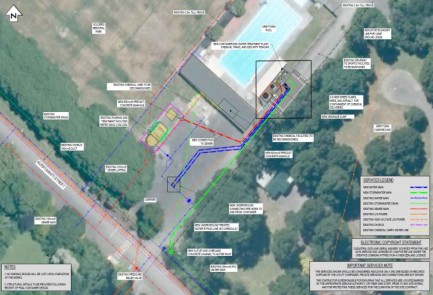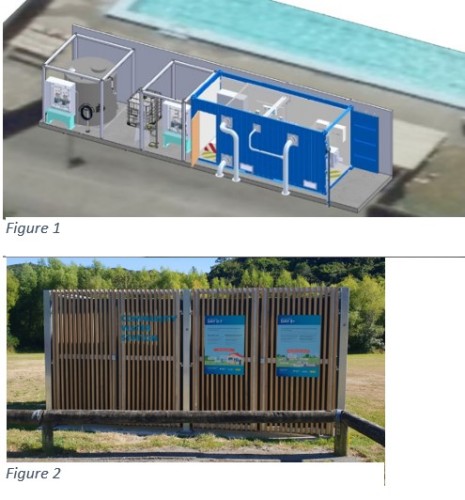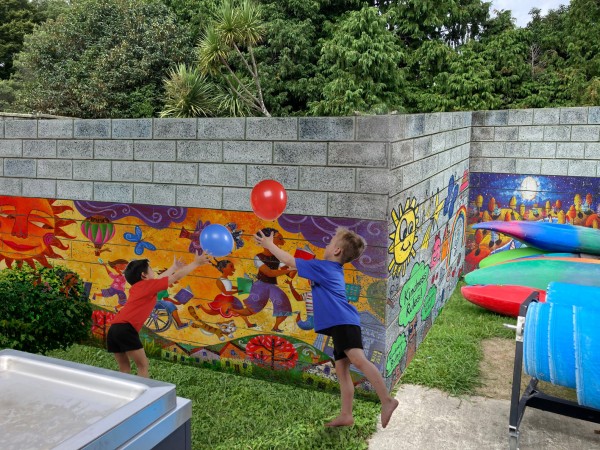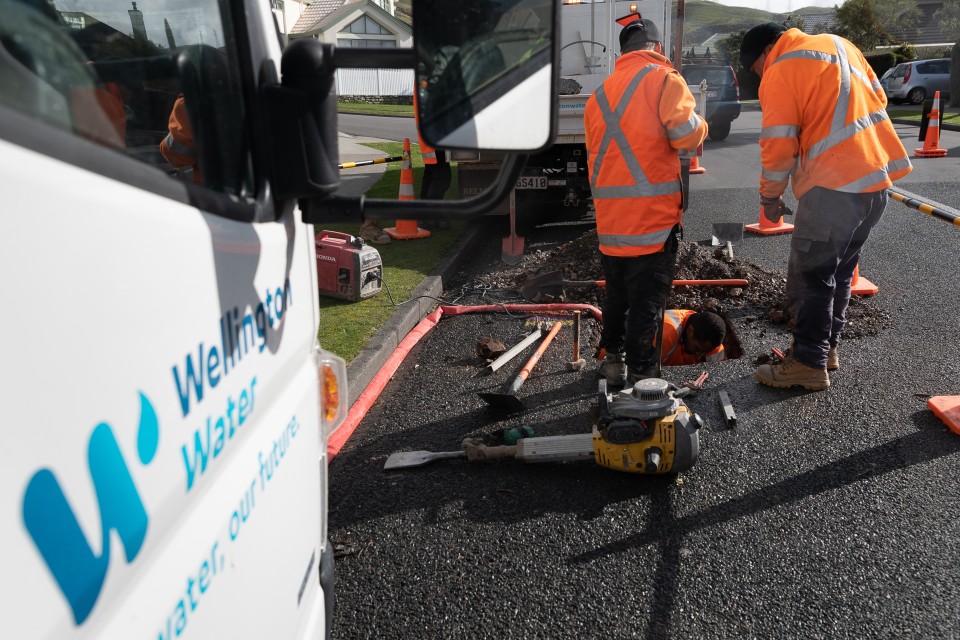Soldiers Memorial Park Water Treatment Plant Upgrade, Greytown
Wellington Water, on behalf of South Wairarapa District Council (SWDC), is upgrading the water treatment facilities at Soldiers’ Memorial Park on Kuratawhiti Street to increase the resilience of the Greytown Kuratawhiti drinking water supply
If you have any questions about this work, please contact:
Wellington Water, 04 912 4400
Latest Updates
Submissions close on proposed new bore
Soldiers’ Memorial Park New Water Bore - Statement of Proposal
Have your say - Soldiers' Memorial Park, Greytown Water Treatment Plant Upgrade Submission Form
Current Status
Public consultation on the proposed new bore as part of the Soldiers Memorial Park water treatment plant upgrades closed on 17 May 2023.
Thank you to those who submitted their feedback. We appreciate your time and effort and really value your input.
The next stage is a public hearing and the committee will make a recommendation to the Infrastructure Committee of the South Wairarapa District Council.
Check out the FAQs on the Background page to find out what people want to know about the project.
Project summary
The current bore and treatment facilities exclusively supply the Greytown Kuratawhiti drinking water needs.
The current bore still meets demand, however:
• The current pump and treatment facilities are ageing and in need of replacement; and
• We cannot switch off the existing pump and treatment facilities to allow maintenance to take place without compromising water supply.
The treatment plant upgrade consists of two elements:
• Installing a new bore to ensure continuity of water supply in the long term
• Installing the new water treatment plant (a containerised system), which involves connecting the plant to the bore and the wider drinking water network.

Project benefits
• Ongoing supply of safe, healthy drinking water to the Greytown Kuratawhiti community.
• Ensure compliance with current national water standards required by Taumata Arowai, New Zealand’s water regulator
• Increased resilience: the new bore will enable Wellington Water to carry out maintenance with minimal impact to the Greytown Kuratawhiti community.
Additional information
For more information on the proposed upgrade, please view our presentation, our Statement of Proposal and Information Sheet
FAQs
How does the Memorial Park water treatment plant upgrade fit into the wider supply strategy for South Wairarapa?
Supply of safe and healthy drinking water to the public on behalf of the South Wairarapa District Council, and all our client councils, is Wellington Water’s number one service goal.
The current treatment plant does not meet the minimum treatment standard expected by the water services regulator, Taumata Arowai, and the upgrade is needed to meet this standard.
As background, when South Wairarapa District Council became a shareholder of Wellington Water in October 2019, the water supplied from the Memorial Park treatment plant was treated with chlorine only. However, this does not provide a treatment barrier against the risk of protozoa as common types like Cryptosporidium and Giardia are extremely hardy and can survive chlorine disinfection. To ensure safe and healthy drinking water is supplied to the community a multi-barrier treatment approach is required. On behalf of SWDC, Wellington Water installed a temporary ultraviolet treatment plant to prevent protozoa contamination, and a further filtration barrier is required to provide a multi-barrier approach as expected by the water services regulator.
Upgrade of the treatment plant to meet the requirements is currently the highest priority project for Wellington Water on behalf of SWDC.
Why don’t we shut down the Memorial Park water treatment plant and focus all investment into the Waiohine water treatment plant?
In short, the Waiohine plant alone is not currently capable of supplying both Featherston and Greytown during high demand periods due to the constraints and hydraulic limitations with the existing supply network.
Longer term, upgrade of the water supply network will remove these constraints however that is several years away and will require significant investment.
In more detail, let’s examine how the supply network currently works. Two treatment plants serve Greytown: the Waiohine plant, which also supplies Featherston, and the Memorial Park plant that supplies Greytown only.
During high demand periods, Greytown relies on the Memorial Park plant operating to provide sufficient water supply pressure. When demand drops below a certain level, such as at night, the Memorial Park plant cannot operate due to its minimum flowrate constraints and it shuts down. This in turn causes the network pressure in Greytown to drop below the set point of a control valve in Humphries St and it opens to supply Greytown from the Waiohine treatment plant.
When demand for water increases again, such as in the morning, the valve closes and the Memorial Park bore restarts to meet the higher demand in Greytown.
Ultimately, without Memorial Park operating during the day, network pressures would drop below that required for firefighting and supply of safe drinking water to areas on the edge of Greytown’s water supply network.
Upgrade of the water supply network in the longer term will remove the network hydraulic constraints and allow Greytown to be supplied from either treatment plant without impacting available fire flow or drinking water capacity. However, this is some years away and will need major investment to achieve.
Meanwhile upgrading the Memorial Park treatment plant is a cost-effective and timely way to ensure safe and healthy drinking water. It will also provide important operational resilience and network flexibility should any unforeseen issue occur, notwithstanding upgrade of the wider water supply network.
Is the Waiohine water treatment plant operating at full efficiency? That is, are the bores producing as much water as possible?
Yes. A fourth bore was installed at the Waiohine plant, and an 8 million litre treated water storage reservoir (bladder) has recently been commissioned that both allow the treatment plant to operate as efficiently as possible.
Why not make the Waiohine treatment plant the primary supply for Greytown, and install the containerised plant in Featherston to supply Featherston residents? This would remove the need for the Tauherenikau pipeline.
As noted in the previous question, the Waiohine treatment plant operating alone is not sufficient to supply Greytown during high demand periods due to network hydraulic constraints. It is also important to build and maintain network operational resilience by having multiple sources of drinking water available when required due to any unforeseen circumstances that could occur at either treatment plant or with the supply pipelines between the treatment plants and Greytown.
If the Memorial Park water treatment plant is supplying water that is deemed safe but not compliant, why bother with lifting it to drinking water compliance?
Maintaining multiple barriers against contamination is one of the six principles of safe drinking water, stated in the Report of the Havelock North Drinking Water Inquiry: Stage 2: ‘Principle 3: Maintain multiple barriers against contamination:
Any drinking water system must have, and continuously maintain, robust multiple barriers against contamination appropriate to the level of potential contamination. This is because no single barrier is effective against all sources of contamination and any barrier can fail at any time. Barriers with appropriate capabilities are needed at each of the following levels: source protection; effective treatment; secure distribution; effective monitoring; and effective responses to adverse signals. A “source to tap” approach is required.’
While the UV system in place provides a barrier and the treatment plant is monitored closely, there remains a risk that the single barrier against protozoa such as Giardia and Cryptosporidium that is in place might fail.
Shouldn’t we discourage having shallow drinking water bores within an urban area? Are we not adding more risk, especially given what happened in Havelock North?
Options for supply of water to Greytown are limited. Most bores near Greytown have been installed into the shallow and highly permeable aged gravel layer that is fed from rainfall and the Waiohine river. Few wells have been installed into the deeper gravels, which suggest they are less productive.
Finding an alternative source of drinking water would require exploratory drilling with no guarantee of sufficient quantity or improved source quality and take significant time and investment to complete.
Provided appropriate barriers to contamination are in place, the shallow ground water can provide a reliable source of safe and healthy drinking water to the community.
The August 2016 Havelock North incident was traced to contamination of the drinking water supplied by two bores in Brookvale Road, on the outskirts of Havelock North, drawing water from an aquifer. That aquifer was thought to be a ‘confined’ aquifer and the water was thought to be secure from contaminants and, as such, the District Council did not treat water drawn from it (i.e. there were no barriers to contamination in place).
Why doesn’t Featherston have its own designated water supply?
In the early 1900’s Featherston sourced its drinking water from Abotts Creek to the west of the township. In 1954 the Boar Bush storage reservoir (concrete tank) was constructed to store water sourced from the Boar Bush Gully stream, and this tank also allowed the water to be treated with chlorine. The Boar Bush Gully storage dam was constructed in the 1960’s to supplement this source, until the 1980’s when a constructed weir and pipeline from Taits Creek (located off Underhill Road on the other side of the Tauherinikau River) connected this new source to Featherston.
The Taits Creek supply could not support the needs of the growing Featherston township and water quality and quantity issues resulted in a pipeline being laid to connect Featherston to the Waiohine water treatment plant adjacent to the Waiohine river. Taits Creek was last used to supply Featherston in about 1999.
Ultimately, the increasing demand of the growing township and need to source better quality untreated water means that the Abbots Creek, Boar Bush Gully and Taits Creek sources are no longer adequate for the needs of Featherston.
Why do we need another bore when there’s one there that works already?
The current bore still meets demand but there is no backup and this creates supply risks. The pump and treatment facilities are very old and need replacing. The older they get, the more risk there is of failure. Without backup, we cannot switch off the pump and treatment facilities to allow for repairs, maintenance, or replacement without compromising supply pressure and fire flow availability to areas of Greytown for extended periods -particularly at times of high demand.
It also means we don’t have the ability to commission the planned new treatment facilities ‘offline’, without causing an extended outage to complete the project, with similar impacts to those noted above for a very long period of time.
The proposed new bore will provide much-needed backup or ‘redundancy’ in the network, and combined with the new plant and treatment facilities, ensure a resilient and reliable supply of safe and healthy drinking water to the Greytown community.
Why is the proposed new bore going inside the swimming pool complex at Soldiers’ Memorial Park? Why not outside, next to the existing bore in the carpark or somewhere else?
A site next to the existing bore was ruled out because it had the potential to interfere with that bore during drilling and operation, risking impacting the water quantity and quality needed to maintain supply to Greytown.
We looked at a total of five locations, including a site in the pavilion carpark which was ruled out due to the planned pavilion extension. Three other sites in Memorial Park were also ruled out as this would impact on protected trees in the area and operation of the sports field.
The next preferred site is just inside the pool complex on the grassed area next to the toddlers’ pool, while the bore and above ground pipework will take up an area about 3m by 6m. It will be fully fenced off from the swimming pool and not visible or accessible from the pool complex.
The shaded grassed seating and BBQ area will continue to be fully accessible from the pool complex.
The treatment plant itself will be discretely located to the side of the Memorial Park baths (indicatively shown in Figure 1, without final treatment plant fencing; Figure 2 indicative fencing), will allow removal of all temporary containers from the car park area, and will also allow removal of the existing chemical storage and dosing room from within the Memorial Park baths building.

How much impact will this have on the swimming pool complex?
Construction is planned to start as soon as possible after obtaining consents, and be programmed to minimise impacts on the pool open season. We anticipate that the impact on day-to-day pool operations will be minimal. The bore and associated above ground pipework will take up a space approximately 3m wide by 6m long. This area will be fully fenced off from the swimming pool, so you will not be able to see or access the bore from the pool complex. The shaded grassed seating and BBQ area will continue to be fully accessible from the pool complex.
What other impacts can we expect during construction?
Access to the swimming pool car park will be restricted to the construction team to ensure we keep residents safe. There will be limited vehicle access to the clubrooms, which will be arranged with local user groups as needed. There will be some construction noise during working hours (7 am – 6 pm) and traffic management on Kuratāwhiti Street at times to enable movement of vehicles into and out of the construction site with deliveries.
What’s the risk of the swimming pool contaminating the new bore?
The swimming pool drains to the wastewater system when it is emptied. The new bore and upgraded treatment plant will increase the level of treatment the water receives, and the risk of contamination from the swimming pool is very low.
The new treatment plant will ensure water supplied to the Greytown Kuratāwhiti community remains healthy, and safe to drink.
Why haven’t other alternatives been explored, such as water supply sources investigated in the past?
Greytown has sourced its drinking water from the Waiohine river since the 1940’s, with a weir being constructed at Bassets Creek. A storage pond allowed water from the river to be treated with chlorine. The Waiohine water treatment plant was constructed in 1999 allowing treated drinking water to be supplied to both Featherston and Greytown.
The increasing demand for drinking water and need to supply sufficient water for firefighting from Greytown’s growing community resulted in an additional bore being drilled at Memorial Park to supplement supply from the Waiohine treatment plant in 2005.
Alternative sources of water for Greytown are very limited. Finding a reliable alternative source not already in use would require exploratory drilling with no guarantee of locating an improved quality or suitable quantity of water to meet Greytown’s needs, and will require significant investment and time to implement.
Soldiers Memorial Park Water Treatment and Bore Upgrade Project - Presentation
Soldiers’ Memorial Park New Water Bore Statement of Proposal
Information sheet - Soldiers Memorial Park Water Treatment Plant New Water Abstraction Bore
All Updates
Submissions have now closed on the proposed new bore as part of the Soldiers Memorial Park water treatment plant upgrade.
Thankyou to those who submitted. We appreciate your time and effort and really value your input.
The next steps are a public hearing after which the committee will make a recommendation to the South Wairarapa District Council Infrastructure Committee.
Check out the FAQs on the Background page to find out what people want to know about the project
This Statement of Proposal for a new bore at Soldiers' Memorial Park in Greytown was adopted by the South Wairarapa District Council on 13 April 2023.
Here's where you can read more detail about the proposal, including the preferred bore location and options assessed.
Click here to read the Statement of Proposal.
Kia ora - this is where you can submit your feedback on the proposed new bore as part of the water treatment plant upgrade at Soldiers' Memorial Park, Greytown. Click here to complete the submission form.
Thank you for your time and effort completing this form, we really value your input.
We're accepting submissions until the 17 May 2023.

